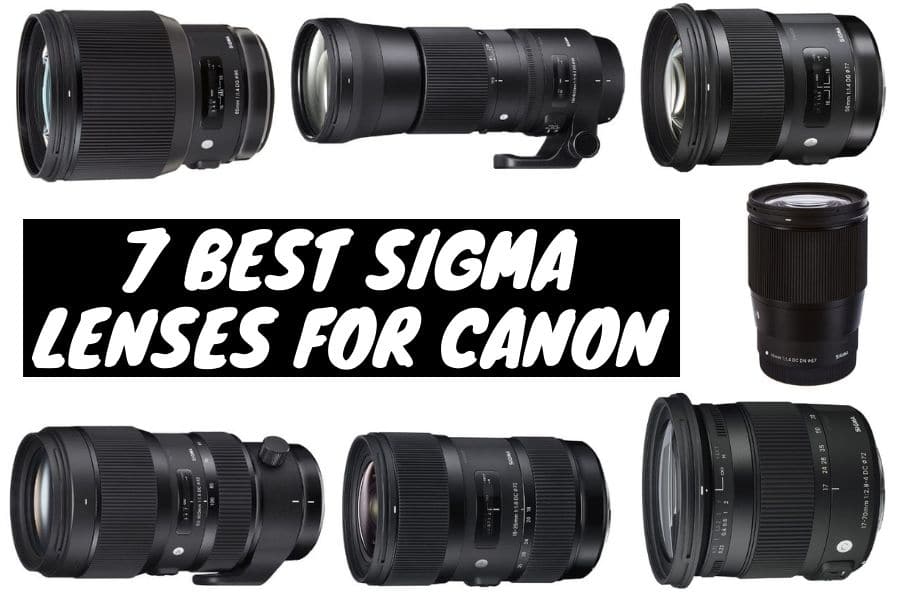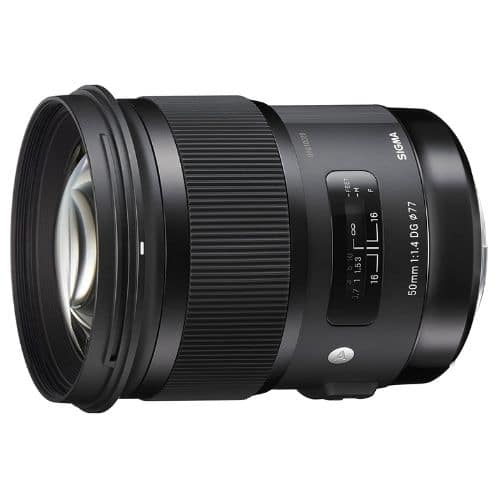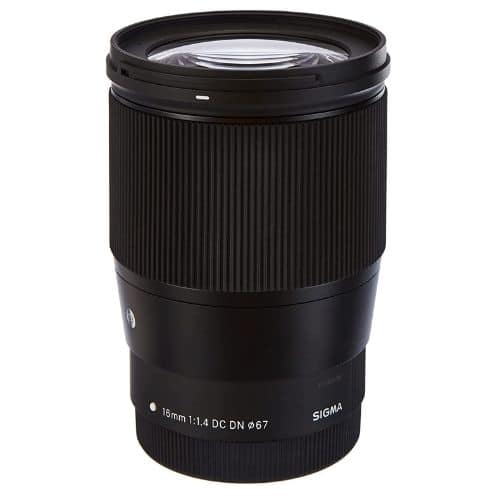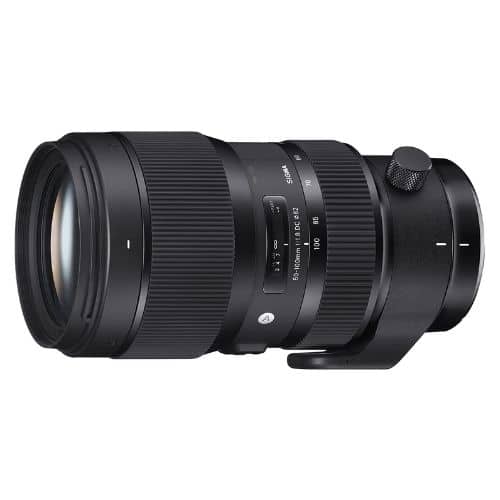As an Amazon Associate I earn from qualifying purchases.
Sigma is one of the most popular as well as reliable camera lens manufacturers in the market. Their lenses are among the most popular lens options for popular camera brands like Canon, Nikon, Sony, and many more. It seems like Sigma has focused on Canon whenever it comes to high-end lenses.
As a result, there are a lot of Best Sigma lenses for Canon available in the market. This content will discuss some of the best and high performing Sigma lenses for Canon. So, keep reading to find out the best lens for your Canon.
Contents
Best Sigma Lenses for Canon Reviews
Sigma lenses are one of the best and popular lenses for Canon Cameras. Here is the review of the top 7 best Sigma lenses for canon.
Our top picks: At a glance
Editor’s Choice: Sigma 150-600mm 5-6.3 Contemporary Lens for Canon
Best Art Lens: Sigma 50mm F1.4 Lens for Canon
Best Functional Lens: Sigma 18-35mm F1.8-Lens for Canon
Best lens for Travel: Sigma 17-70mm f/2.8-4 Lens for Canon
Best lens for Portrait photographers: Sigma 85mm f/1.4 Lens for Canon
Best Budget-friendly Lens: Sigma 16 mm f/1.4 Lens for Canon
Best lens for Canon APS-C: Sigma 50-100mm F1.8 Lens for Canon
1. Editor’s Choice: Sigma 150-600mm 5-6.3 Contemporary Lens for Canon
This Sigma 150-600mm 5-6.3 Contemporary lens is one of the most popular Lenses for Canon. This lens offers excellent telephoto reach, solid image stabilization, and fast focusing at a reasonable price. It will give you a crisp handheld capture with a slow shutter speed. Overall this lens is one of the best picks in this budget that makes it the editor’s choice.
Design and Build Quality
This camera lens is of great value with high-quality design and construction. Its high-quality matt finishes, premium quality plastics, and metals make it sturdy. Even though it’s less bulky, lighter, and less expensive, it doesn’t have the look, feel, or performance of a budget lens. For a 600mm lens, this one isn’t terribly heavy.
Focus Accuracy
In terms of focusing precision, this lens is good and even exceptional. A focus scale is located at the very tip of the lens, and it displays the range at which the camera’s current focus is adjusted. The focus ring on this Sigma Contemporary lens is big and ridged for better grip. Both extremities of the range have hard stops, making it simpler to concentrate at infinity. Its zoom is a great performer when it refers to auto-focusing.
Lens Controls
The controls on the lens are a bit different compared to others150-600mm lenses. There are four switches on this lens, and these four are for Auto Focus, limiting focus, image stabilization, and Custom modes. So, you will be able to fine-tune the Auto Focus behavior of the lens. You can also change the picture stabilization system’s settings and save your changes.
Overall Performance
When compared with other lenses, this Sigma looks like a great deal. It ensures maximum aperture, sharpness in the center of the frame is superb at 150mm. The lens produces excellent sharpness in the center with maximum aperture and extremely nice sharpness towards the edges while zooming in 300mm. At 600mm, the resolution is good in the center of the frame and pleasing towards the corners.
Pros
- It includes a lens hood and a tripod collar
- It has excellent image stabilization capability
- Comes with excellent sharpness and quick focus
Cons
- It is not thoroughly water splash and dust-proof
2. Best Art Lens: Sigma 50mm F1.4 Lens for Canon
The Sigma 50mm f/1.4 DG HSM Art lens is a unique piece of kit. Its remarkable low-light performance and crispness are the reason for this. In the hands, the lens feels quite substantial and has a good appreciation of it. Overall, this Art lens is unquestionably a high-quality lens for Canon with autofocus.
Excellent and Classy Build
This art lens features an excellent design quality. Sigma didn’t have to seek inspiration for this lens’ form. From the stylish matte as well as gloss finish towards the excellent sharp rubber rings, this lens is beautifully designed. Because of its small size and low weight, it’s an excellent short telephoto lens for portrait photography.
Handling Feature
It appears to be well-made and capable of withstanding the daily rigors of professional use. The auto/manual focus switch is located on the left side of the camera. As a result of the rubber components, such as the focusing mechanism and the grip, this camera gives a solid grip and is easy to use.
Focus accuracy
To continuously generate clean shots, focus precision and repeatability are essential. This Sigma Art lens comes with excellent repeatability. There is not a big difference in focus whether the lenses focus from a closer range or infinity, and there is no slack in the movement of the focus ring. The focus-action has 90 degrees throw, and it is pretty short for precise wide-open focusing.
Image Quality
The image quality of this art lens is said to be superb. It is also very sharp in the middle of the frame, with gradual softening toward the image circle’s periphery. Even at this broad range aperture, full-frame edges are nicely crisp. At the center of the image, there is a slight improvement. At this angle, the corners sharpen beautifully.
Pros
- Ensure well-controlled color and brightness
- This lens is compatible with several cameras
- Offer an excellent and outstanding image quality
Cons
- This lens is a bit big as well as heavier
3. Best Functional Lens: Sigma 18-35mm F1.8-Lens for Canon
Sigma 18-35mm F1.8-Lens for Canon is a standard zoom lens with a maximum aperture of f/1.8. It is the world’s first zoom lens with a constant /1.8 aperture. The lens is intended to provide exceptional performance and is perfect for artistic and creative purposes. This one is compatible with Sigma USB Dock, which allows users to fine-tune lens characteristics and update the firmware.
Build and Craftsmanship
Lens design and build quality have a lot of impact on capturing photos. A bulkier lens will not provide you with better handling of the camera. This lens comes with excellent design and build quality. The matte black surface of the lens lends it a subtle and discreet appearance. Despite Sigma’s claims of weight-saving design, the lens feels reasonably substantial and has a standard heft.
Autofocus Operation
This lens has an excellent autofocus mechanism since it is a crucial part of lenses. Thanks to the electronic Hyper Sonic Motor that makes this autofocus faster. In its most basic form, autofocus was quick, easy to lock onto objects, and didn’t seem to affect when focusing. Autofocus will operate with all the cameras since it includes a build-In focus motor.
Sharpness and Brightness
The constancy of performance over the whole focal range is outstanding. Even totally exposed at /1.8, this lens is incredibly crisp, which isn’t often the case with incredibly wide lenses. The lens performs well at 18mm, both within the center and in the mid-frame. At 35mm, the mid-frame, as well as corners, appear the best, resulting in a better balance of brightness across the frame.
Image Quality
When it comes to picture quality, this lens will utterly wow you. Colors seem to be well represented in the photographs as well. The lens delivers vibrant, stunning hues that stand out when it comes to colors. The level of constancy in performance over the whole focal range is quite outstanding. In addition, the lens does not have problems with excessive field curvature.
Pros
- It offers excellent sharpness and a wide aperture
- Capture photos with a blurry and smooth subject
- It allows capturing an excellent photo in low light
Cons
- This lens doesn’t have any optical stabilization
4. Best lens for Travel: Sigma 17-70mm f/2.8-4 Lens for Canon
The Sigma 17-70mm f/2.8-4 is a lens that stands out from the crowd. Designed for artists who have surpassed the standard ‘kit’ zooms that come with camera bodies. It has a larger aperture and covers a more extended and broader field of vision. When you add image stabilization as well as a macro magnification of 1:2.9 at 70mm, you have a highly flexible optic.
Minimal Design
The design of this Macro OS Lens is minimal. It’s compact, light, yet well-balanced for a lens with this focal length. The lens’s overall construction feels robust, and all of the switches are really sharp and well-executed. The zoom ring, like the focusing ring, rotates smoothly. A floral lens hood is included with this lens, which adds a stylish touch to the whole product.
Aperture and Sharpness
The broad focal length range allows for much compositional flexibility. It also allows the photographer to take photographs that are pretty wide-angle. Despite being a constant aperture range, the 17-70mm’s aperture range still seems to be extremely useful in most scenarios. The sharpness is quite good, even wide open at f/2.8 with chromatic aberrations visible.
Image Stabilization
This lens is a cost-effective option that is also a good lens in its right. An optical image stabilizer incorporated into a lens is gradually becoming more of a need than a luxury, as more and more people want it. An optical Stabilizer or OS has been used for this lens as its Image stabilizer system. The Sigma’s OS did a fantastic job of eliminating camera shake.
Overall Performance
Although this lens is the best budget solution, it performs relatively well and will never disappoint you. The overall clarity is excellent, and distortion is much reduced. The presence of the violet refractive error improves as well as the sharpness of the edges. Because of the f/2.8-4 aperture, it is feasible to photograph in less than ideal lighting conditions.
Pros
- Features a compact and lightweight design
- Excellent sharpness and controlled brightness
- This lens is compatible with the Sigma USB dock
Cons
- It has some Color distortions but is not very prominent
5. Best lens for Portrait photographers: Sigma 85mm f/1.4 Lens for Canon
If you are looking for a portrait lens for your compact camera, Sigma 85mm f/1.4 Lens is the best way to go. This lens has been designed for intermediate to professional photographers, and it performs well. This lens ensures excellent image quality with an f/1.4 maximum aperture. The sharpness is excellent as well as the bokeh is exceptional. Overall, this one is one of the best and ultimate camera lenses for portraits.
Excellent Build Quality
This Sigma lens is an impressive one for portraits with excellent bokeh. Manufactured with all premium quality materials, it is hefty as well as has a standard weight. The lens seems to have a solid and flower-shaped lens hood, which is thankfully constructed of plastic. The focus ring takes up practically the whole front half of the lens.
Portrait Giant
Sigma’s Art series is known for its excellent quality as well as brightness. This is precisely what this Sigma lens does. It’s a fantastic lens in every way. As immediately as you hold it in your hands, you can sense it. If you want to take the most remarkable portrait photographs, this Sigma lens should be at the top of your list.
Focusing Performance
Sigma’s Hyper Sonic Motor is used in the construction of this art lens. Autofocus is relatively quiet, and in fact, you have to work hard to hear anything in the autofocus motor when it is working well. The Art lens does, in fact, have a somewhat smooth focus transition. The fact that the lens likewise focuses quite accurately is really more significant.
Image Quality
Image quality is one of the significant aspects that you should consider before purchasing a new camera lens. This lens offers an excellent and exceptional image quality. Every corner of the picture is excellently brighter as well as sharper. This lens is totally free from distortion, and it has no issue with backlighting. The overall image quality is excellent and never disappointed.
Pros
- It is exceptionally sharp and has no distortion
- It is compatible with the MC-11 Mount converter
- The hypersonic motor ensures excellent AF control
Cons
- This lens is expensive than other lenses
6. Best Budget-friendly Lens: Sigma 16 mm f/1.4 Lens for Canon
Are you seeking a budget Sigma lens for your Canon-branded camera? Sigma 16 mm f/1.4 Lens is one of the best budget camera lenses for Canon. It is a brilliant documentary lens with such a fixed focal length. Although it is a budget option, it is able to perform well. This lens is highly sturdy and quite well against dust as well as water splashes. Overall, it is one of the best ways to go in terms of a budget camera lens.
Solid Lens Design
The lens has a robust and well-made feel it. The handling is really simple, yet it is pretty elegant. The focus ring, which is beautiful and broad and moves with exquisite smoothness, is the sole moving feature. This is due to the fact that it is electronically connected to the extremely quiet stepping motor that operates the focusing mechanism rather than relying on a mechanical connection.
Focusing
The focusing of this lens is much too fast as well as accurate. It allows smooth autofocus when capturing photos and recording videos. The E-mount version of this lens is aimed to allow the most out of Sony’s Fast Hybrid AF technology, which is available on specific Sony cameras. There is no high-resolution stabilization on this lens, as there is on the other Sigma lens in the range.
Aperture and Brightness
The Sigma Art lens features 9 circular lamellae in its aperture. It generates a really lovely bokeh for micro-43 when paired with high f/1.4 brightness. These bokeh spheres of a strong source of light now have a border in the background when shot at maximum aperture. There is no chromatic aberration on the sides. Although transverse refraction as well is reduced, it may still be seen at f/2.
Overall Performance
Now it is time to talk about the overall performance of this budget lens for Canon. Although it is a budget lens, it will never disappoint you with the performance. There is no issue with the clarity and contrast in the image since the lens maintains that aspect excellently. It is also possible to keep ghosting and flare under control, but the same is true for barrel distortions.
Pros
- It comes in a compact and lightweight design
- Accurate autofocus and excellent aperture
- Affordable but perform like an expensive one
Cons
- For certain Micro Four Thirds cameras, it’s a little big
7. Best lens for Canon APS-C: Sigma 50-100mm F1.8 Lens for Canon
An older lens with a fast, constant aperture as well as short to medium telephoto ranges for Canon EF cameras. This lens replaces three primes without compromising a fast aperture. Thankfully, Sigma delivered a superb performance, even completely open, with clear details and few distortions. This lens further pushes the edge by combining a fast-maximum aperture with a wide range of focal lengths.
A hefty lens
From the minute you take this lens out from the box, you’ll recognize it’s a high-quality lens. Metal & polycarbonate combine in the barrel, which has a metal tripod ring that spins and locks into place every 90 degrees. It’s not precisely a lens you throw in your baggage for a day out, weighing 3.3 pounds and measuring 6.7″ long. This also implies that it is heavier than a handful of primes in the very same range.
Autofocus Examination
The precision of the autofocus system is, of course, crucial. Fortunately, this Art lens offers an excellent Auto Focus capability. Bearing the HSM acronym in its name, this Art Lens has Sigma’s Hypersonic Motor AutoFocus drive system. It focuses externally quickly and quietly, with just the lens groups shifting within. Full-Time Manual focusing is also available in this lens.
Aperture and sharpness
The lens is crisp, which appears to be a primary emphasis of Sigma’s redesign. It is entirely compatible with USB Docks for firmware upgrades and focuses adjustment. Distortion is, for any and all intents, non-existent, which makes sense given the focal length. Normal to intermediate telephoto lenses are often pretty excellent when it comes to reducing distortion.
Image Quality
Sigma improved light transmission and maximum aperture on the F1.8 lens. This functionality ensures an overall improvement to the lens. There is no issue with color as well as the brightness of the captured image. The image quality is reasonably uniform from corner to corner as well as distortion is also well controlled. The 7D’s excellent shooting capabilities are used to benefit from the fast focus.
Pros
- The maximum aperture is quite bright
- Sigma USB Dock is compatible with this lens
- Available for a variety of operating systems
Cons
- A bit bulkier as well as relatively expensive
How to choose the right lens- Camera lens Buying Guide
It’s not always simple to figure out which lenses are best suited to your requirements. Many acronyms and requirements need to be learned, and various manufacturers use entirely different abbreviations for the same qualities. Here is a list of the most crucial characteristics to keep in mind while purchasing a new camera lens.
Aperture
When purchasing a lens, an aperture is a vital characteristic to consider. The aperture is the size of the hole in the lens that allows light to pass through the sensor. A lens with a larger aperture will indeed be your best choice if you often operate in low light. When shooting handheld or rapidly moving objects, a larger aperture allows you to employ quicker shutter rates. You may also boost the bokeh using lenses with larger apertures.
Image stabilization
Image stabilization is a function that is designed to eliminate blur in photographs. It is especially beneficial while operating handheld or even in low illumination circumstances. While this is a popular feature on later model lenses, it’s worth double-checking to see whether it’s accessible on older models as well. The initials IS, VR, OS, or VC stand for image stabilization.
Sensor type
Lenses that are particularly designed for the crop, as well as full-frame cameras. When looking at lenses, it’s important to remember what sensor the camera utilizes. Before purchasing any lens, determine the crop factor of your camera and use it to determine the lens’ effective focal length. Despite the fact that the focal length stays the same, the smaller sensor reduces the angle of vision.
Focal lengths
Another significant factor to consider when purchasing a new lens is the focal length. The focal length of a lens is measured in millimeters and indicates whether it is a wide-angle and telephoto lens. A telephoto lens will automatically bring you closer to distant things. On the other hand, Wide-angle lenses are ideal for capturing more of the scenery in nature photography.
Fixed or Zoom
A zoom lens seems to be the most suitable option. Because you can have different focal lengths in one lens, you can get by using fewer lenses to satisfy your demands. Two focal lengths are always mentioned in zoom lenses. On the other hand, a Fixed lens is smaller as well as lighter than zoom lenses, and they generally have more brightness.
Frequently Asked Question (FAQ)
Are Sigma lenses good quality?
Sigma is one of the most reliable cameras and camera-related accessories manufacturing brands in the world. They manufacture all excellent quality lenses that are most popular in the market. Image quality with the Sigma lenses is superb, with excellent clarity, contrast, as well as color transfer.
Are Sigma art lenses worth it?
Sigma Art lens is the most cost-effective alternative to professional expensive art lenses. These lenses generate photos that are sharper, more realistic, and individually colored. A Sigma Art lens might be a fantastic choice even for first-time contemporary art photographers.
What is an 18-35mm lens good for?
Although the 18-35mm length is too wide for most activities, it could be used for the restricted niche of athletic events that this focal length is designed for. The f/1.8 lens is ideal for sports photography, particularly indoor sports photography.
Is Sigma 150-600 worth it?
In my viewpoint, the Sigma 150-600mm lens is well worth the money spent on it. Because it is weighty, hand holding the camera should be done with caution. It also enjoys natural light as well as has a moderate learning curve.
What is a 50 100mm lens good for?
While this will be insufficient for most large-field sports photos, it will be enough for some. Closer range sports, and particularly indoor sports, are excellent choices for a 50-100mm.
Final Thought
There are a lot of lens manufacturing brands available for Canon-branded cameras. However, Sigma is one of the best and most popular lens manufacturers. In these Best Sigma lenses for Canon, we presented the 7 best lenses for Canon that are manufactured by Sigma. So, if you are seeking a new lens for your camera, this article will be beneficial for you.
As an Amazon Associate I earn from qualifying purchases.








